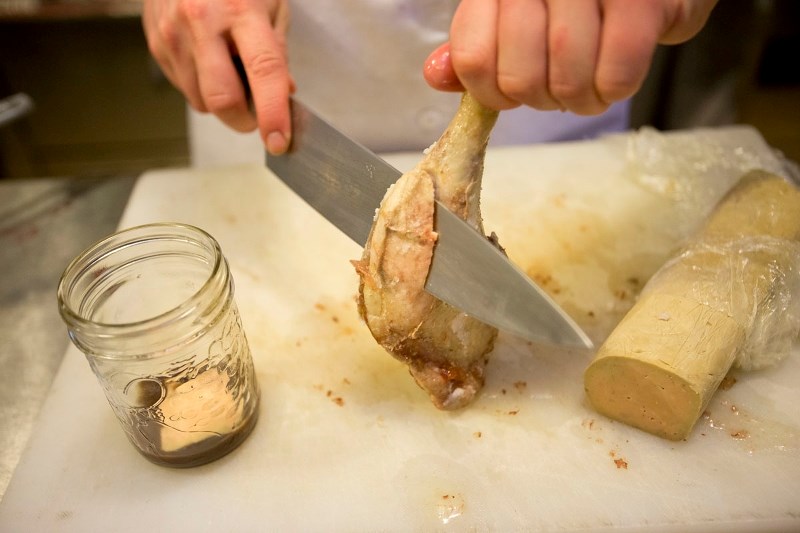If there is one item on River House Restaurant's menu that necessitates the presence (if not the overabundance) of fat – it's duck confit.
For the confit, duck trimmings are slowly rendered on low heat, releasing a sizable amount of liquid fat. Duck legs – one of the fattiest parts of the bird – are braised then submerged into a pool of their own fat.
The end result is a silky, luscious, fall-off-the-bone, melt-in-your-mouth hunk of duck flesh.
Confit is a French culinary technique for preserving duck in its own fat, since bacteria cannot thrive in dense fat. Confit of any protein can last months if not polished off in one sitting.
"When we didn't have refrigeration, people used fat to cure, to congeal and to cover – if it has a fat cap, there's no air getting in," says Nate Henry, head chef and owner at River House.
Henry's job is to make food taste good. A large part of that revolves around fat – from fruity, slightly peppery golden olive oil, to smooth, creamy cheeses and salty, crackling pork belly.
Fat makes meat tender – as evidenced by thick marbling in a rib-eye steak. Fat makes things crispy – when plunged into a vat of liquid fat and deep-fried on high heat.
Fat makes things tastes good. And the best part is, you need it.
"We need fat. We need fat for cell structure, for hair and nails and skin. We need it for hormone production. It's not something we can go without," says Diane Jackshaw, a registered dietitian in St. Albert.
A common misconception is that too much fat makes you fat, she says.
But it's not quite as simple as that.
"The body is very good at converting things to fat. Even if you have too much carbohydrate or protein, your body will want store it," says Jackshaw.
"Fat isn't the bad guy."
Breaking down the fat
Aside from needing fat for cell structure and hormone production, fat also gives you energy (calories).
When fat is broken down, it yields nine calories per gram – twice as much energy per gram compared to proteins or carbohydrates, says Jackshaw.
The Canada Food Guide recommends that no more than 30 per cent of an adult's total daily calories should be made up of fat.
Dietary fat is important, especially for the absorption of vitamins A, D, E and K.
A recent study published in the Journal of the Academy of Nutrition and Dietetics showed that dietary fat made a difference in vitamin D levels in a group of 50 healthy men and women.
Participants took a large dose of vitamin D3 (50,000 international units) with a breakfast consisting of egg whites, fruit, toast and cranberry juice. The "fat" group had either olive oil (monounsaturated) or corn oil (polyunsaturated) mixed in, accounting for 30 per cent of the calories of the meal.
Compared to the fat-free group, the fat group had 32 per cent greater absorption of vitamin D. There was no difference whether the fat was olive oil or corn oil.
"If you do not have fat on board, you could run into malabsorption issues and deficiencies," says Jackshaw, warning that since those vitamins are stored in the body, "mega dosing" as it is known, can lead to vitamin toxicity.
The Canada Food Guide states that no more than 10 per cent of daily fat intake should come from saturated fat.
Saturated fats are "bad" fats. Looking at their chemical structure, all available places where a hydrogen atom can bond to a carbon atom is occupied, making it "saturated." Saturated fats are solid at room temperature, which in part explains why saturated fats tend to clog arteries, says Jackshaw.
Trimming the fat
Unsaturated fats, such as monounsaturated fat and polyunsaturated fat, are "good" fats. These fats are found in vegetable oils, nuts and seeds and fish. Omega-3 and 6 fatty acids are derived from unsaturated fats and have anti-inflammatory properties that prevent and treat heart disease.
Most people associate saturated fat with animal-based fat, but coconut oil, which has become a popular fat in recent years, is also a saturated fat.
Coconut oil is unique in that it contains a high percentage of medium-chain triglycerides, which are easier to digest than long-chain triglycerides, prevalent in most oils.
"Research coming out now shows that maybe we've been painting everything with a broad brush, saying all saturated fat is bad, which isn't necessarily true," says Jackshaw. "Now we're looking into different types of (saturated fats). Coconut oil may not be as bad as once thought."
In agreement with several public health authorities, the Dietitians of Canada and the Canadian Heart and Stroke Foundation, Jackshaw cautions consumers from blindly accepting the wonders of coconut oil, such as increasing metabolism or improving an Alzheimer's or Parkinson's disease prognosis.
The research doesn't fully support it ... yet.
If you do like cooking with coconut oil, keep away from refined products, she says.
"Coconut oil is often highly processed and made into a trans fat. Hydrogenated, partially hydrogenated or modified coconut oil – those are likely trans fats, which are not good for you."
Trans fats, "the ugly" as dubbed by Health Canada, is made from the chemical process of partial hydrogenation – when hydrogen is added to unsaturated fat it becomes solid fat. Trans fats typically come from commercially fried foods and baked goods.
Jackshaw advises adopting the 80:20 rule when it comes to fat and your diet – eat as recommended by the Canadian Food Guide 80 per cent of the time, while 20 per cent is reserved for holidays and special occasions.




